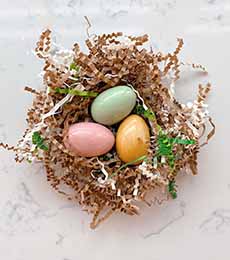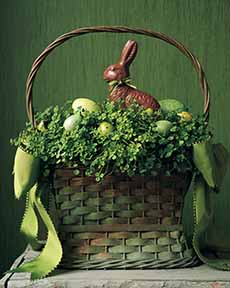Gourmet Chocolate Easter Eggs For Your Easter Basket
|
|
Ah, the days when we were satisfied with a Cadbury buttercream Easter egg, available at just about any store that sold chocolate. Today, only gourmet chocolate Easter eggs please our palate. Take these gourmet chocolate Easter eggs (photo #1) from Markham + Fitz Chocolate Makers in Bentonville, Arkansas (birthplace and headquarters of Walmart). Two University of Arkansas alumni pooled their savings in 2014 to buy their first pieces of chocolate-making equipment. The result: beautiful chocolate of the highest quality. Their Easter BonBons are shiny examples of the artisan’s craft: colored chocolate shells with different fillings: Easter BonBons are sold in boxes of 15 (BYO nest). Get yours at MarkhamAndFitz.com. Easter is the second-bestselling candy holiday in America after Halloween—and Easter candy is often much better than that which is collected by trick-or-treating. While spring lamb, dyed eggs, and hot cross buns all trace their origins to the pagan spring festivals of ancient times, candy is a newcomer, dating back just to the 1800s. It was then that European candy-makers first hand-crafted chocolate eggs for the holiday. They were wildly popular. Each Easter in our youth, we’d look forward to an Easter basket chock-full of candy: chocolate eggs filled with buttercream and marzipan, chocolate bunnies, jelly beans, marshmallow chicks, and other goodies, nestled in shredded paper “grass” and tied with a big bow. Children around the world received Easter baskets like this. As the tradition evolved, even adults got Easter gifts. But how did the tradition begin? Let’s start way back. To ancient cultures, the spring equinox marked the transition from the cold, dark days of winter to the warmer, sunny days of spring. Farmers planted their crops (most people were farmers or hunters, or otherwise relied on those who were) and prayed to their gods for a bountiful harvest. There would be rituals and festivities honoring the gods. Anglo-Saxons, for example, held feasts in honor of the goddess of spring and fertility, Eostre. The Christian holiday of Easter was named for her. In early Christianity, fasting was common practice. The tradition of Lent evolved, a fasting period leading up to Easter. As Christianity spread through Western Europe from the fifth through 12th centuries, the observance of Lent did as well [source]. As some Christians gave up sweets as their Lenten sacrifice, the return to eating them after 40 days without it was a nice reward. The stage was set for Easter sweets. Easter basket. The symbolism of the basket stretches back thousands of years prior to the Easter celebration of the Ressurection of Jesus Christ. In an eighth-century book “The Reckoning of Time,” Eostre was depicted cradling a woven basket in the crook of her arm—the beginning of the Easter basket tradition. The concept of Easter baskets and the Easter bunny (called Easter hare, Osterhase, in German) was brought to America in the 18th century by German immigrants. Easter baskets began a widespread tradition in the late 19th century, around the same time as the German “Osterhase” became the Easter Bunny. Easter eggs. Eggs have historically been mythological motifs for new life. Ancient Egyptians, Asians, and Greeks all believed in the premise of the world being born from a cosmic egg. According to many sources, the Christian custom of Easter eggs was adopted from Persian tradition following the early Christians of Mesopotamia, who stained them red in memory of the blood of Christ. When they are cracked open, the eggs are said to represent Jesus’ emergence from the tomb and His resurrection. The Christian Church officially adopted the custom [source]. Easter rabbit. The Easter Bunny has been the recognizable symbol of Easter since the 1700s [source]. Originally called a hare, from medieval times the prolific rabbit was a symbol of fertility. German immigrants continued the concept of the egg-delivering white hare, along with the tradition that children would prepare nests in which the hare could leave brightly colored eggs. The rabbit’s Easter morning deliveries expanded to include chocolate and other types of candy and gifts, while decorated baskets replaced nests [source 1] [source 2]. Jelly beans. The modern jelly bean is believed to have been invented in the U.S., sometime after 1850. Due to its egg shape and festive colors, it became an Easter tradition in the 1930s. Here’s the history of jelly beans. Easter egg hunt. The custom of the Easter egg hunt comes from Germany. Its origins may date to the late 16th century, when the Protestant reformer Martin Luther organized egg hunts for his congregation. The men would hide the eggs for the women and children to find [source]. In Germany and then in the U.S., children would leave out stockings and hats to be filled by the Easter Bunny. Children also built nests out of leaves and sticks. This brought the tradition outdoors—and later engendered the Easter egg hunt in the U.S. [source]. German immigrants were also the originators of the candy Easter egg, which was first made of sugar and pastry in the mid-1800s. Candy eggs became wildly popular in the mid-1800s. By the late 1800s, U.S. candy makers sold hollow and filled chocolate eggs, jelly eggs, and exquisite panorama sugar eggs, hollow egg-shaped sugar shell with an open end that revealed an Easter panorama made from paper [source]. By the early 20th century, improvements in equipment and processes led chocolate makers to produce Easter candy on a much larger scale: molded rabbits, birds, nests, and other designs appeared. Soon, Easter candies of every description were being mass-produced: rabbits and chicks in every pose, for starters, became Easter basket staples, and affordable to most consumers. Malted milk eggs, peanut butter eggs, marshmallow eggs, white chocolate carrots colored orange…so many Easter treats, so little time. The early 20th century also saw jelly beans be added to the Easter basket. While chocolate-covered marshmallow eggs had existed for some time, in 1953, Peeps marshmallow chicks in yellow and white debuted in Brooklyn. With the 21st century, big snack brands got the message and began to produce, for example, Almond Joy, Cadbury, Hershey’s, M&Ms, Nerds, Oreos, Reese’s and Tootsie Rolls in Easter colors and/or wrappers. And the rest is history (although our history is to stick with artisan chocolate). *We’re not totally snobby. While we dislike most mass-marketed chocolate because it’s overly sweet, we have two exceptions: York Peppermint Patties and Twix bars. |
|
|
CHECK OUT WHAT’S HAPPENING ON OUR HOME PAGE, THENIBBLE.COM. |
||









